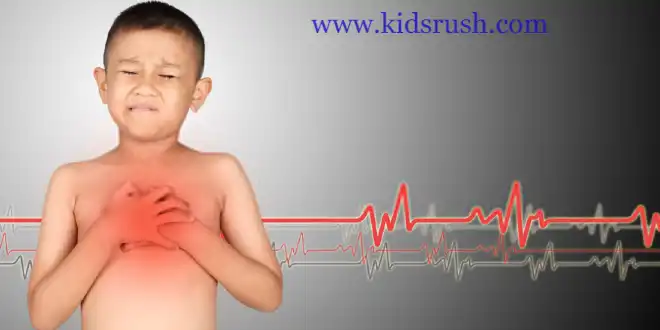Rheumatic fever is an inflammation of the joints, heart, skin, and nervous system as a result of the complication of a strep throat infection that has not been treated. In this article on kidsrush.com, we will tell you the causes, symptoms, and treatment of rheumatic fever in children. Let’s start!
Causes of rheumatic fever in children
- This disease results from an untreated strep throat infection.
- Children have a combination of joint pain, fever, chest pain or palpitations, uncontrollable jerking movements, a rash, and small nodules under the skin.
- The diagnosis is based on the symptoms.
- The best way to avoid rheumatic fever is to treat any strep throat infection with early and complete antibiotics.
- Aspirin (acetylsalicylic acid) is given to relieve pain and antibiotics to clear the strep infection.
Although rheumatic fever occurs after a strep throat infection ( strep throat ), it is not an infection itself. Rather, it is an inflammatory reaction to a strep infection. The parts of the body most frequently affected by inflammation are:
- Joints
- The heart
- The skin
- The nervous system
Most people with rheumatic fever recover, but permanent heart disease occurs in a small percentage of cases.
Rheumatic fever can occur at any age but is most common in children between 5 and 15 years of age. Currently, in the United States, for example, rheumatic fever rarely develops before the age of 3 or after the age of 21 and is much less common than in developing countries. Probably because antibiotics are used early in the treatment of streptococcal infections. However, sometimes the incidence of rheumatic fever rises and falls in a particular area for unknown reasons. Overcrowded conditions, malnutrition, and low social and economic status appear to increase the risk of rheumatic fever. Heredity appears to play a role because the tendency to develop rheumatic fever often runs in families.
In the United States, for example, a child with untreated strep throat is estimated to have a less than 1-3% chance of developing rheumatic fever. However, about half of children who have previously had rheumatic fever develop it again with another strep throat infection if this infection is not treated.
Rheumatic fever occurs after strep throat infections but not after strep infections of the skin ( impetigo ) or other parts of the body. The reasons are unknown.
Rheumatic fever in children: Symptoms
The symptoms of rheumatic fever vary greatly, depending on the part of the body affected. Symptoms typically begin 2 to 3 weeks after the throat symptoms clear up. The most common symptoms of rheumatic fever are:
- Joint pain
- Fever
- Chest pain or palpitations caused by inflammation of the heart
- Uncontrollable jerking movements (Sydenham chorea)
- Eruption
- Small subcutaneous lumps (nodules)
The child may have a single symptom or several.
Joints
Joint pain and fever are the most frequent symptoms at the beginning. One or more joints suddenly hurt and become tender to the touch. They may also be hot, swollen, and red. Joints may be stiff and contain fluid. The ankles, knees, elbows, and wrists are usually affected. The shoulders, hips, and small joints in the hands and feet can also be affected. As the pain in one joint decreases, pain in another begins (called migratory pain).
Joint pain can be mild or intense and usually lasts about 2 weeks and in very few cases more than 4.
Rheumatic fever in children does not cause chronic joint damage.
Heart

Some children with heart inflammation have no symptoms, and the inflammation is identified years later when a heart injury is discovered. Some children feel that their heart rate is very fast. Others have chest pain caused by inflammation of the sac that surrounds the heart (pericardium). Children may have a high fever, chest pain, or both.
Heart murmurs are sounds that are made when blood flows through the heart. Children often have silent heart murmurs. However, loud or changed murmurs sometimes mean a child has a heart valve disorder (valvular disease). When rheumatic fever affects the heart of the children, the heart valves are usually affected as well, causing new, louder, or different murmurs to appear that doctors can listen to with a stethoscope.
Heart failure is also possible, causing a child to feel tired and short of breath, with nausea, vomiting, stomach pain, and a dry, persistent cough.
The inflammation of the heart gradually clears up, usually within 5 months. However, it can permanently damage the heart valves, leading to rheumatic heart disease. The likelihood of developing rheumatic heart disease varies depending on the severity of the first flare-up of inflammation and also depends on whether recurrent streptococcal infections are treated.
In rheumatic heart disease, the valve between the left atrium and ventricle (mitral valve) is the one most often injured. This valve may become insufficient ( mitral valve regurgitation ), abnormally narrow ( mitral valve stenosis ), or present with both of these conditions. Damage to the valve produces the characteristic valvular heart murmur that allows the physician to diagnose rheumatic fever. Years later, usually during middle age (40-60 years), valve injury can cause heart failure and atrial fibrillation (an abnormal heart rhythm).
Skin

A flat, painless rash with a wavy border (erythema margins) may appear as the other symptoms subside. Its duration is short, sometimes less than 1 day.
Children with heart or joint inflammation may develop small, hard, painless lumps (nodules) under the skin. The nodules usually appear near the affected joints and disappear after a while.
Nervous system
In children with rheumatic fever, uncontrollable jerking movements may begin gradually (usually in both arms and legs and particularly in the face, feet, and hands, called Sydenham chorea), although they usually begin only after all other symptoms have decreased. It may take 1 month before the jerky movements become intense enough for the parents to take the child to the doctor. At that time, the child presents rapid, involuntary, sporadic movements, which disappear when sleeping. These movements affect any muscle, except the eyeballs. They can start in the hands and spread to the feet and face. Facial grimaces (a distorted expression on the face) are common. Children can click their tongues or put their tongues in and out of their mouths quickly.
In mild cases, children appear clumsy and have slight difficulties dressing and eating. In severe cases, they need protection from being hurt by the involuntary movements of their legs and arms. The chorea lasts between 4 months and 8 months.
Rheumatic fever in children: Diagnosis
- Established clinical criteria
- Cultures of samples of discharge from the throat
- Blood test
- Electrocardiography and often echocardiography
The doctor makes the diagnosis of rheumatic fever based on a combination of symptoms and test results called the Modified Jones Criteria.
Blood tests are done to check for elevated levels of antibodies to strep. Doctors also look for strep in samples of discharge from the child’s throat that are sent to a laboratory for testing.
Other blood tests, such as erythrocyte sedimentation rate (ESR) and tests for C-reactive protein, help doctors determine the presence of inflammation in the body and, if so, how extensive it is. ESR and C-reactive protein increase when there is inflammation.
An electrocardiogram (ECG, recording of the electrical activity of the heart) is ordered to look for cardiac arrhythmias caused by inflammation of the heart. Your doctor may do an echocardiogram ( an ultrasound image of the structures of the heart) to diagnose heart valve abnormalities and heart inflammation.
If you are not sure whether the joint redness and swelling are caused by a joint infection rather than rheumatic fever, you can use a needle to extract fluid from the joint (joint aspiration or arthrocentesis ) and analyze it.
Forecast
Rheumatic fever in children and some of the problems it causes, such as inflammation of the heart and Sydenham’s chorea, can come back. Sydenham chorea episodes usually last several months and resolve completely in most cases, but the disorder reappears in approximately one-third of those affected. Joint problems (such as pain and swelling) are not permanent, but inflammation of the heart can be permanent and serious, particularly if strep infections recur and are not treated.
Heart murmurs caused by rheumatic fever eventually go away in some cases, but most sufferers have permanent murmurs and some degree of damage to the heart valves.
You May Also Like:
- How To Cure An Ear Infection In Children
- Iron Deficiency Anemia In Children
- Hearing Impairment (Hearing Loss) In Children
Rheumatic fever in children: Treatment
- Antibiotics
- Aspirin (acetylsalicylic acid)
- Sometimes corticosteroids
The treatment of rheumatic fever in children has three goals:
- Elimination of any residual strep infection
- The reduction of inflammation, particularly of the joints and the heart and, therefore, the relief of symptoms
- Prevention of future infections
The doctor gives the child with rheumatic fever antibiotics to clear up any residual infection. Single long-acting penicillin injection is prescribed, or penicillin or amoxicillin is given orally for 10 days.
Aspirin (acetylsalicylic acid) is given in high doses for several weeks to reduce inflammation and pain, particularly if the inflammation has affected the joints and heart.
Some other non-steroidal anti-inflammatory drugs (NSAIDs), such as naproxen, can be as effective as aspirin (acetylsalicylic acid), but for most children, aspirin is preferred for the treatment of rheumatic fever.
If the cardiac inflammation is severe, to further reduce the inflammation, intravenous or oral corticosteroids such as prednisone along with aspirin are recommended.
Children should limit their activities if they suffer from joint pain, chorea, or heart failure. Children without heart inflammation do not have to limit their activities once the disease subsides. Prolonged bed rest is not beneficial.
Preventive treatment of Rheumatic fever in children (antibiotic prophylaxis)
The best way to avoid rheumatic fever is by rapid and comprehensive antibiotic treatment of any strep throat infection.
Also, children who have had rheumatic fever should take medications (usually penicillin) by mouth daily or by monthly injections intramuscularly to help prevent another strep infection. When antibiotics are given to people who have not yet contracted an infection, this preventive treatment is called prophylaxis. It is not clear how long this preventive treatment should be continued. The duration depends on the severity of the disease and is usually continued for at least 5 years or until age 21 (whichever lasts longer). Some doctors recommend its continuation for life in certain cases, such as people with long-lasting valvular disease and who have contact with young children (as these can carry streptococcal bacteria).
